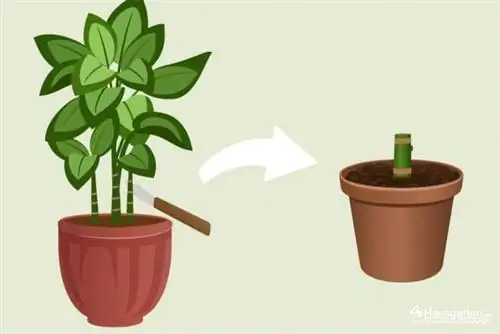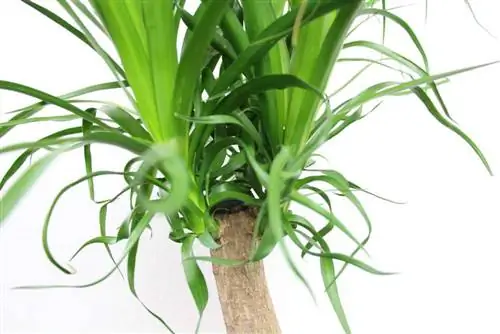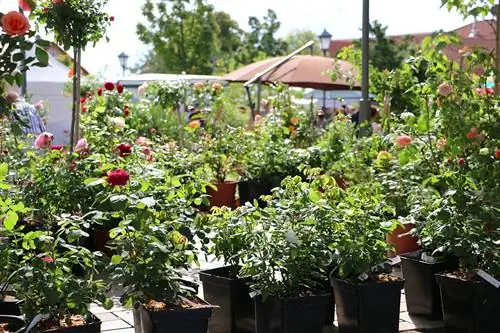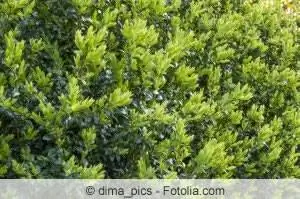- Author admin [email protected].
- Public 2023-12-17 03:39.
- Last modified 2025-01-24 12:45.
Every hobby gardener knows that you can not only grow plants from seeds, but also propagate them vegetatively. This takes advantage of their ability to form complete plants from parts. Depending on the type of plant, leaves, shoot tips or even pieces from the shoots are used. One of the most popular types of cuttings is the stem cutting. With our tips, cultivation is guaranteed to be successful.
What are stem cuttings?
The two most common ways of propagating cuttings are head cuttings and stem cuttings. They are applicable to most plant species. The difference between a head cutting and a stem cutting is simply explained: the former is a shoot tip that consists of a stem and usually a few leaves. Stem cuttings, on the other hand, are all pieces without a shoot tip. A borderline form between these two types of cuttings is a stem without a shoot tip that has formed side shoots. Most plants that can be propagated from top cuttings can also be grown from stem cuttings.
The right time
Depending on the type of plant, the timing for propagating cuttings can vary greatly. In general, however, a stem cutting should, if possible, not be cut during the flowering phase of the plant. Most plants can be propagated between May and August. It is usually a good idea to use the process when the plant is being cut anyway. For all plants that do not easily form new roots, the timing depends primarily on the maturity of the shoots. Shoots that are too soft are very susceptible to rot; on the other hand, excessive woodiness makes rooting difficult. For deciduous trees, it is recommended to cut them during the leafless resting phase in winter.
- Perennials and herbaceous plants: Early summer to summer
- Woods: Late autumn to winter
- evergreen garden and balcony plants: August to November
- Houseplants: March/April
Suitable plants
Propagation via stem cuttings is often used for perennial house or pot plants. Hardy trees and shrubs are also good candidates. In general, only plants that have no roots, i.e. no refined plants, should be used for cultivation. A good indication of whether a plant is suitable for propagation by cuttings is the following rule: If it sprouts easily after a cut into older wood, then the plant can also be grown from stem cuttings. Some houseplants are grown almost exclusively from stem cuttings:
- Dieffenbachia (Dieffenbachia)
- Dracaena (Dracaena)
- Club Lily (Cordyline)
- Window leaf (Monstera)
- Palm lily (Yucca filamentosa)
- Radiated Aralia (Schefflera)
- Spurge (Euphorbia)
- Palm Lilies (Yucca)
Deciduous and especially coniferous woods are a little more difficult to grow. For boxwood, for example, root formation can take up to a year.
Source material
A cutting is always an exact copy of the mother plant. It therefore has the same characteristics, for example in terms of gender or height. It is simply encouraged to form its own roots using special culture methods in order to grow into a young plant. Therefore, it goes without saying that the mother plant must be he althy and free of pests for propagation to be successful.
- young, herbaceous shoots (not too soft)
- without flower base
- Shrubs and trees: slightly woody shoots
- preferably annual shoots from the previous year
The right tool
The most important thing when cutting is that the plant's cells are not crushed. Therefore, it is best to cut the trunk or shoot with a single, pulling cut using a sharp, clean knife. If the tissue is too hard or very woody, as is often the case with the Yucca palm, a sharp tree saw can also be used.
The optimal interface
In order for a plant to be able to form new roots and shoots from a section, stem nodes, so-called nodes, are necessary. There is a large amount of valuable plant tissue at the base of a bud, a leaf or a branch. This contains important reserves that promote the growth of new roots and shoots. Depending on the type of plant, these buds can be large or tiny. You don't have to look for the buds on a leafy cutting. In this case, a leaf base or a side shoot is considered equivalent.
Tip:
A protruding piece up to the bud base should not be longer than about five to ten millimeters, as this delays the rooting process.
The ideal length

The optimal length of a stem cutting can vary greatly depending on the size and vigor of the mother plant. Cuttings of low-growing plants such as ground cover plants can often only be a few centimeters long, while cuttings of woody plants can be around 15 to 20 centimeters long. The minimum length is easy to find out. The distance between two leaf nodes or buds is characteristic of each plant. In technical jargon it is called internode. In order for a plant to actually grow from the stem cutting, it must be at least one internode long. The cut is therefore always made just below or just above a so-called sleeping eye, so that the cutting ends with a bud at the top and bottom.
- Yucca: 20 to 30 cm
- Columnar cacti and euphorbias: at least three times the diameter
- spherical succulents: not shorter than the diameter
Avoid infections
Pathogens easily enter the plant through the interfaces. To reduce the risk of infection, the cut site must dry before placing the stem cutting in water or soil. So place the shoot pieces on a few sheets of kitchen roll for a few hours. If you have cut a lot of cuttings, it is a good idea to dry them in pots with crumpled newspaper or perlite. This allows enough air to reach the wounds and they can close quickly. You should dab weeping interfaces with kitchen roll and disinfect them with charcoal dust.
- Disinfect cutting tools
- create as small an interface as possible
- Let wounds dry
- alternatively dip in charcoal powder
Tip:
In spurge plants, pay attention to the milky sap that comes out. This irritates the mucous membranes. It is best to dab it with a kitchen paper towel soaked in hot water.
Rooting in a water glass
In general, it is possible to propagate cuttings either in soil or in water. A decisive criterion for or against one of the two methods is the risk of rot, which is much higher in pure water. For this reason, this method is unsuitable for all plants such as succulents, cacti or the yucca palm, which prefer it to be dry. To root, simply place the stem cutting in a glass of water in a partially shaded location. If possible, the cutting should not rest on the ground, otherwise roots cannot form there.
The Matching Earth
For most cuttings, growing in substrate is the better method. Remove all lower leaves and insert the shoot a few centimeters deep into the slightly moistened substrate. When growing cuttings, generally use nutrient-poor, water-permeable and, above all, sterile soil. Recommended substrates for propagating cuttings are:
- growing soil
- Cactus soil
- Mixture of sand and peat
- Coconut fibers
Tip:
Put the shoot so deep into the soil that at least one former leaf base or sleeping eye is covered. The roots grow out of them and the lower interface.
Tips for rearing
If you pull the stem cuttings on the windowsill in a heated room, it is important to maintain the humidity. To do this, place a freezer bag upside down on the pot and secure it with a rubber band. At the same time, this means increased maintenance costs, as the bag has to be ventilated from time to time. It is easier to work without a cover. To do this, it is sufficient to place the cuttings in a moderately warm, partially shaded place in the room or outdoors and initially spray them regularly with water. A stem cutting takes a few weeks to months to root. If the cutting sprouts, this is a sign of good root formation. From now on the plant can be grown like a normal young plant.






